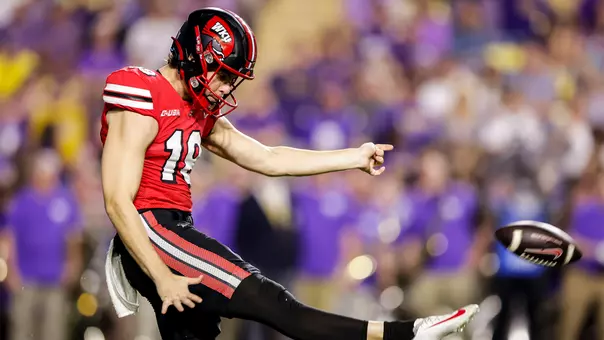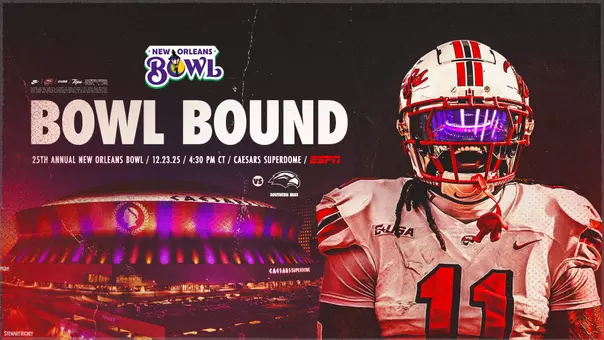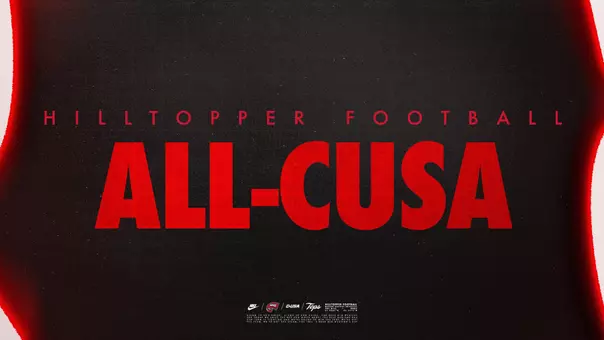Western Kentucky University’s transition from Division I-AA (Football Championship Subdivision) to becoming the 120th member of Division I-A (now known as the Football Subdivision – the move will be complete in 2009) is simply a natural next step.
WKU was an NCAA Division II member from 1973 to 1977, with two appearances in the national championship game.
The Hilltoppers then moved to Division I-AA in 1978, made seven trips to the playoffs in 24 seasons and won the 2002 national title.
“We use it (the move to I-A) as a sales pitch,’’ says head coach David Elson, in his fifth season at the school. “WKU football has a great winning tradition.
“We were successful in Division II; we were successful in I-AA. History shows that we know how to do it.’’
Elson’s optimism is mirrored by athletic director Dr. Wood Selig.
“I thought that we’d be crazy not to go (I-A),’’ he says. “We were in no-man’s land, losing more money every year. We could either go back to the days of talking about dropping football or make an investment in the future of the program.
“Moving was the only good option,’’ says Selig.
Elson says he’s confident the school is “really ready,’’ for making the move, in terms of how it has scheduled and the financial model. “It doesn’t get any better for a coach than to have the support of a president like Gary Ransdell and an AD like Wood Selig,’’ he says.
Ransdell, while optimistic generally, says the school will have to know its limitations.
“We’re not going to seat 80,000 people at $35 a ticket. But, we can be successful,’’ he says.
“Sooner or later, the Sun Belt will have a BCS team. It’s not realistic to expect us to compete with the Florida’s and Auburn’s. But we can compete year-in and year-out with the Mid-American Conference, the Western Athletic Conference……”
Selig says eight different schools have called him since WKU made the move last November, asking for advice on the Hilltoppers’ blueprint for making the change. Since the NCAA, concerned that I-A might be becoming too large, recently declared a four-year moratorium on schools moving up a division, the Toppers’ timing seems particularly noteworthy. “We had a hunch they might do that,’’ says Selig, “but that was just one of (several) reasons.’’
Western Kentucky University will be considered as a reclassifying institution for the 2007 and ’08 seasons. The first season it will be eligible to participate for the Sun Belt Conference championship and a berth in a bowl game is 2009. What WKU folks are saying about the move to become the 120th Division I-A program:
WKU president Dr. Gary Ransdell: “This helps us achieve a national vision and raises the brand of WKU. It also breathes energy across campus.’’ What would success look like? In the short term, “7-5 in 2009,’’ he says. In the long term, “getting to a BCS game.’’ Ransdell cites five significant things that have happened since the move became official in November 2006, none of which he says would have occurred otherwise. 1) Season ticket sales are at 6,000, compared to 1,800 last year. 2) Marketing rights were sold to Host Communications. 3) On Aug. 17, WKU signed an exclusive apparel contract with Russell Athletic. 4) Future home games include Army, Navy, Indiana, Iowa State and Miami (Ohio). 5) The naming rights to L.T. Smith Stadium were sold for $5 million to Houchens Industries. “The quality of life in Bowling Green, Kentucky has improved because of this move,’’ says Ransdell, who was named the school’s president in 1997. While emphasizing, “we can be successful,’’ Ransdell says that WKU must know its limitations. “It’s not realistic to expect us to compete with the (upper echelon) teams, but, in time, we can consistently compete in the middle range of Division I-A football.
“If Boise State can do it, we can do it.’’ The Broncos, who joined I-A in 1996, achieved a BCS win within 10 years when they beat Oklahoma 43-42 in dramatic fashion in last January’s Fiesta Bowl. An impact of that win has been that season ticket sales sold out this season at 21,000, according to a school spokesperson.
WKU athletic director Dr. Wood Selig: “We’re not looking at a move to I-A as a potential short-term financial windfall. It’s like the stock market – to realize full financial potential, you have to stay in for a longer period.’’ Selig says he spoke to all 18 schools that have made the transition from I-AA to I-A in the last 20 years, but focused on Connecticut, South Florida, Troy and Marshall, as each has enjoyed a level of success. While it is difficult to gauge how much financial impact the move will mean to WKU, Selig cited an example: “Our best I-AA payday was $400,000,’’ he says. “When we play at Nebraska in 2010, we’ll get $800,000.’’ Like Ransdell, he also alludes to the Boise State model as one the Hilltoppers would like to emulate.
Head football coach David Elson: “Last December, we spoke to the players. There are so many positives with the move. Obviously, the next two years have some negatives (no post-season play). We told them: 1) It is what it is, to use a current clich; and 2) This is important for Western Kentucky’s history and tradition, not only for football, but the whole university, and the players could be a part of that.’’
Elson says he and the team decided on the slogan “Making History,’’ as its rallying point. “We also set two goals for the 2007 season – to go 7-5, and to go undefeated at home (which would mean wins over traditional rival Eastern Kentucky and defending Sun Belt champion Troy).
“Although we can’t compete for the Sun Belt championship, we told the players that nothing says we can’t create our own little championship.’’ Elson says he has promised the players if they attain the two goals, they will be rewarded with some kind of commemorative gift, like a watch or ring, which the NCAA allows.
Elson says his concerns have more to do with logistical items like managing 85 scholarships instead of 63, recruiting and hiring office help and support staff.
Legendary Hilltopper coach Jimmy Feix: “I’m excited, almost envious of the challenge that those young people face.’’ Feix says he remembers when WKU moved from Division II to I-AA and that the next step, to I-A, is “the right thing, and they have a good game plan to get it done.’’ He says the most difficult part will be getting “quality players – there just aren’t a whole lot around (particularly in Kentucky high schools). They may have to look at junior colleges, particularly for linemen.’’ WKU didn’t play any Division I-A programs when Feix coached – “We were entirely state-supported (financially),’’ he says, “so we didn’t have to play them. Now they do.’’ Asked if, in particular, the Topper teams of 1973 and 1975, both of which reached the Division II championship game, would have been competitive with, say, the University of Kentucky, he said, “We would have been competitive. Whether we would have won or gotten beat up, I don’t know.’’
Hilltopper linebacker Blake Boyd, who transferred from Louisville: “Speed and depth (are the two biggest differences between I-A and I-AA), but I feel our players can compete with anybody.’’
Hilltopper quarterback David Wolke, who transferred from Notre Dame: “You really don’t think about it being I-A or I-AA in a game. You’re going totally on muscle memory in terms of technique, and it’s just 11 people out there playing. The move to I-A and the renovation of the stadium are going to be special. I’m real excited.’’
Former ‘Topper defensive back Mel Mitchell, now with the New England Patriots: “The biggest thing will be the I-A guys are a lot bigger and faster. Depth is a factor, too – against Florida, for example, their third string is a good as the first string.’’ Mitchell cited WKU’s game against Wisconsin in 2001 as an example: “We played competitively with them for a half (trailing 17-6 before losing 24-6), then we started getting guys maimed.’’
How has WKU fared recently against Division I-A programs: 2001, lost to Wisconsin 24-6; 2002, lost to Kansas State 48-3; 2003, lost to Auburn 48-3; 2004, beat Florida International 35-14; lost to Kansas State 27-13; 2005, lost to Auburn 37-14; 2006, lost to Georgia 48-12.
How schools making the move from I-AA fared in their first official I-A season: 2006, Florida International (0-12), Florida Atlantic (5-7); 2002, Connecticut (6-6), Troy (4-8); 2001, South Florida (8-3); 1999, Buffalo (0-11), Middle Tennessee (3-8); 1997, Marshall, (10-3, lost in Motor City Bowl); 1996, Alabama-Birmingham (5-6); Boise State (2-10); Central Florida (5-6); Idaho (4-7). That’s a cumulative first-year record of 52-87, and one bowl appearance.
-- A special contribution by Don Collins, a 1976 graduate of Western Kentucky University, who recently retired after 25 years with USA TODAY newspaper












